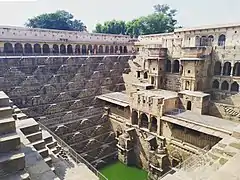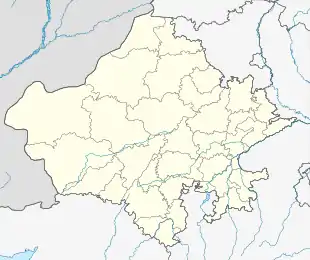Chand Baori
Chand Baori is a stepwell situated in the village of Abhaneri in the Indian state of Rajasthan.[1][2][3]
| Chand Baori | |
|---|---|
 | |
 Location within Rajasthan | |
| General information | |
| Architectural style | Mihir bhoj |
| Town or city | Bandikui |
| Country | India |
| Construction started | c. 800 |
| Completed | c. 1800 |
| Design and construction | |
| Architect | Local |
History
Chand Baori is said to be named after a local ruler called Raja Chanda.[4] However, no epigraphic evidence has been found regarding the construction of the Chand Baori or the adjoining Harshat Mata Temple. Based on similarities in style and carvings with the terraced temples of Paranagar and Mandore, the Baodi can be dated to 8th-9th century.[5] It was likely constructed before the temple.[6] The Chand Baori is one of the few stepwells that has "two classical periods of water building in a single setting". according to Morna Livingston in Steps to Water: The Ancient Stepwells of India[1]
The oldest parts of the step-well date from the 8th century onwards, An upper palace building was added to the site, which is viewed from the tabulated arches used by the Chauhan rulers and the cusped arches used by the Mughals. Access to these rooms is now blocked for tourists.[1] The upper stories with the columned arcade around it were built around the 18th century during the Mughal era.[7] The Mughals also added art galleries and a retaining wall around the well. Today, there are remains of old sculptures and carvings, which were suggested to be in the temple or in the various rooms.[1] The nearby Harshat Mata Temple was a pilgrimage site and formed a complex together with the well. Many of these stepwells, including Chand Baori, served multiple purposes including drawing water and religious or ceremonies activities.[3] This unique form of underground well-architecture remains constant from the 7th century in the existing monument.[3] Excavated stones of the temple are now kept by the Archaeological Survey of India in the arcades of the well. Chand Baori plays an important part of the main current of architectural activity in western India.
Overview
Chand Baori is a deep four-sided well with a large temple on the back face of the building.[2] The basic architectural aspects of a monumental well consist of a long corridor of steps leading to five or six story below the ground level which can be seen at the site.[3]
Chand Baori consists of 3,500 narrow steps over 13 stories. It extends approximately 30 m (100 ft) into the ground, making it one of the deepest and largest stepwells in India.
The state of Rajasthan is extremely arid, and the design and final structure of Chand Baori was intended to conserve as much water as possible. Ancient Indian scriptures made references to construction of wells, canals, tanks and dams and their efficient operation and maintenance.[2] This site combined many of these operations to allow for easy access to local water.
At the bottom of the well, the air remains 5-6 degrees cooler than at the surface, and Chand Baori was used as a community gathering place for locals during periods of intense heat. One side of the well has a haveli pavilion and resting room for the royals.
In media
Chand Baori has been used as a filming location for a number of films, such as Bhoomi, The Fall, Bhool Bhulaiyaa, Paheli, and in 2012 The Dark Knight Rises with Christian Bale as Batman.[8][9][10]
Images
 Steps of the well
Steps of the well Arched arcade around the well
Arched arcade around the well Stone carved window of the royal haveli
Stone carved window of the royal haveli
References
- Safvi, Rana. "A mathematical marvel called Chand Baori". ProQuest. Kasturi and Sons Ltd. Retrieved 25 October 2019.
- Voudouris, Konstantinos; Kaiafa, Asimina; Xia Yun, Zheng; Kumar, Rohitashw; Zanier, Katharina; Kolokytha, Elpida; Angelakis, Andreas (March 2017). A Brief History of Water Wells Focusing on Balkan, Indian and Chinese Civilization (1 ed.). Aristotle University of Thessaloniki, Cesme-Izmir, Turkey: IWA 2nd Regional Symposium on Water, Wastewater and Environment. pp. 465–476. Retrieved 20 October 2019.
- Singh, Aditi; A. Mishra, Soma (October 2019). "Study of Ancient Stepwells in India" (PDF). International Journal of Research in Engineering, Science and Management. 2 (10): 632–634. Archived from the original (PDF) on 4 December 2019. Retrieved 23 October 2019.
- "ASI: Chand Baori". Archived from the original on 5 March 2016. Retrieved 3 February 2019.
- Chandramani Singh, ed. (2002). Protected Monuments of Rajasthan. Jawahar Kala Kendra. p. 176–177. ISBN 978-81-86782-60-6.
- Cynthia Packert Atherton (1997). The Sculpture of Early Medieval Rajasthan. BRILL. p. 64. ISBN 90-04-10789-4.
- Morna Livingston (2002). Steps to Water: The Ancient Stepwells of India. Princeton Architectural Press. pp. 38–39. ISBN 978-1-56898-324-0.
- https://www.youtube.com/watch?v=SbeyN25dLEs
- https://foxnomad.com/2016/11/01/cave-batman-found-soul-rural-indian-village/
- https://traveltodriveblog.wordpress.com/2016/09/11/chand-baori/